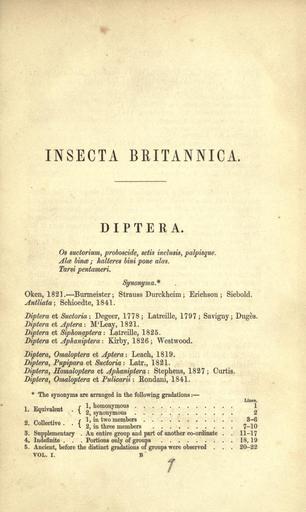MAKE A MEME
View Large Image

| View Original: | InsectaBritannicaVolume1page1.jpg (601x1005) | |||
| Download: | Original | Medium | Small | Thumb |
| Courtesy of: | commons.wikimedia.org | More Like This | ||
| Keywords: InsectaBritannicaVolume1page1.jpg en Insecta Britannica Volume1 page 1 SYNONYMA The Synonyma is very technical but it is partially given here to illustrate the clarity and logical nature of Haliday's procedure as well as the huge knowledge to which it was applied None of the books listed which are in several languages are easy reading The synonyms are arranged in the following gradations - 1 homonymous Line1 1 Equivalent 2 synonymousLine 2 1 in two membersLine 3-6 2 Collective 2 in three members Line7-10 3 Supplementary An entire group and part of another co-ordinate Line11-17 4 Indefinite Portions only of groups Line18 19 5 Ancient before the distinct gradations of groups were observed Line20-22 Insect Britannica - This that and the other thing - Synonyms for the Order Diptera Line 1 Oken 1821 --Burmeister; Strauss Durkheim; Erichson; Siebold Haliday is explaining here that his use of the name Diptera is precisely equivalent to that of the authors listed Line 2 Antliata Schioedte 1841 Here Haliday is stating that his use of the name Diptera is for an identical systematic group which Shiodte named Antliata Line 3 Diptera et Suctoria Degeer 1778; Latreille 1797; Savigny; Dugès Here Haliday is saying that his systematic group named Diptera includes the Suctoria or fleas a group separated from the Diptera under the name Suctoria by Degeer Latreille Savigny and Dugès Line 4 Diptera et Aptera M'Leay 1821 McLeay unlike Haliday considered the fleas a separate order for which he used Linnaeus name Aptera Line 5 Diptera et Siphonaptera Latreille 1825 Modern authors unlike Haliday consider the fleas a separate order from the Diptera using Latreille's name Siphonaptera for them Line 6 Diptera et Aphaniptera Kirby 1826; Westwood Westwood called the fleas Aphaniptera as do some modern authors From 7-10 Three order level groups not two are included in Haliday's single order Diptera Line 7 Diptera Omaloptera et Aptera Leach 1819 A third group is introduced- the Omaloptera These perplexing insects in which the young are born in a stage like the pupa are really Diptera as Haliday thought According to Leach Omaloptera Aptera and Diptera are separate orders Line 8 Diptera Pupipara et Suctoria Latr 1821 Latreille called the insects Leach had called Omaloptera Pupipara He called the fleas Suctoria Latreille thought all three were separate orders Line 9 Diptera Homaloptera et Aphaniptera Stephens 1821 Curtis Here called Homaloptera Diptera and Aphaniptera are treated as three separate orders Line 10 Diptera Omaloptera et Pulicarii Rondani 1841 In this work Rondani reverted to the spelling Omaloptera and called the fleas Pulicarii In the next group of synynoyms 11-17 Haliday merges an entire group and part of another co-ordinate From here on the situation becomes complicated and more detail than Haliday gives is necessary for complete understanding Line 11 Diptera et Aptera p Linnaeus 1753; Geoffroy; Müller; Olivier p means part ie only part of the Aptera are included Line 12 continuation of 11 Cuvier; Dumeril; Meigen; Fallen; Zetterstedt The entire group here is Diptera only the Aphaniptera or fleas are included here by Haliday although this is not stated Line 13 Halterata et Pedestria p Scopoli 17 The Halterata are a whole group within the Diptera Only part of the Pedestria which are partially also Diptera Line 14 Muscoides et Oniscoides p Laicharting 1781 These names are seldom found the work is obscure Line 15 Halteriptera et Rophoteira p Claireville 1798 Again the names are obscure and the purpose of their inclusion is to eliminate them Line 16 Diptera et Antennidia p Rafinesque 1815 Rafinesque considered the Antennidia a separate and equivalent group to the Diptera Here Haliday is merging the two Line 17 Aptera et Diptera p Lamarck Lamarck's Diptera included insect groups other than Diptera Line 18 Angioptera p Linnaeus 1735 Haliday was uncertain as to exactly what Linnaeus writing in 1735 had meant by Angioptera hence the term Indefinite Linnaeus initially divided the insects into four orders Coleoptera Angioptera Hemiptera and Aptera Diptera were only part of the order Angioptera Line 19 Antliata p et Ryngota p Fabricius 1775; Illiger etc Haliday is rendering these groups redundant Ancient synonyms And for completeness Haliday includes Ancient before the distinct gradations of groups were observed These names go back to antiquity Aristotle lived from 384-322 BC Pliny from 23-79 AD Martin Lister was a much later figure 1775-1858 Line 20 Diptera et Aptera p Aristoteles Line 21 Bipennia et Impennia p Plinius Line 22 Anelytra Bipennia c Lister http //www biodiversitylibrary org Alexander Henry Haliday 1851 PD-old-100 Insecta Britannica Diptera Haliday | ||||